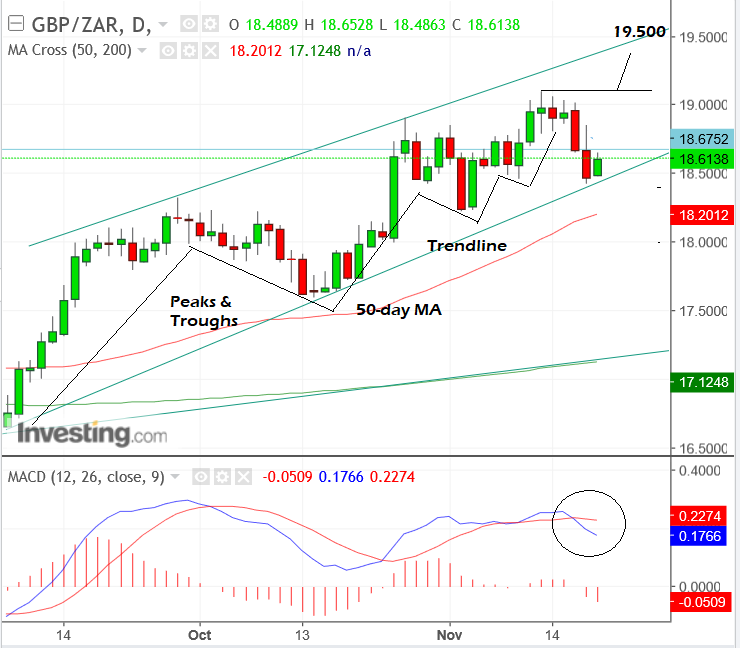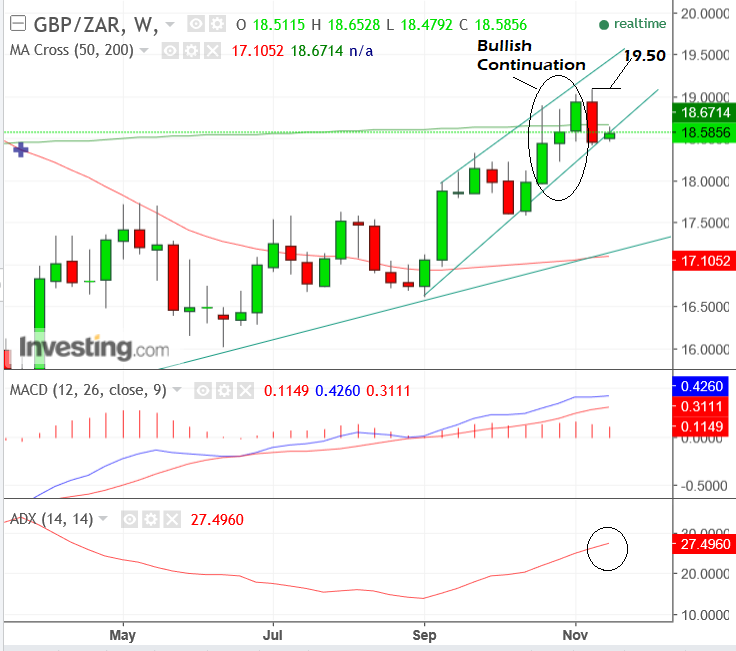Pound's Uptrend vs. South African Rand Intact: Week-Ahead Preview

A credit rating review of South Africa, a meeting of the SARB and ongoing political risk suggest the possibility of volatility; whilst in the UK the chancellor unveils his autumn budget and charts still recommend more upside.
Our latest technical studies of the Pound-to-South African Rand exchange rate confirm a sequence of rising peaks and troughs; indicative of the pair being caught within an established uptrend.
Trends normally continue until they show signs of reversal and although GBP/ZAR has weakened recently, falling from its 19.10 highs down to the current market level of 18.59 this is not yet enough to evidence a reversal.
The uptrend remains intact, therefore, and is expected to extend, but we would ideally wish to first see it break above the 19.1030 highs, for confirmation of a continuation, with the next target to the upside situated at 19.5000.
We would become more negative if the exchange rate broke below its trendline and moved down to the level of the 50-day Moving Average at 18.20.
Momentum, as measured by MACD, has crossed its signal line (circled) and is pointing sharply lower, which is a negative sign for the pair.

The weekly chart (below) continues to show a bullish continuation pattern composed of three consecutive rising weeks (circled), the first one of which is a long, green week, the second, a week with a much shorter green body and the third and final week, made up of another long, green up-candle.
The pattern is indicative of more upside, especially when accompanied with an ADX indicator reading of between 20-30, which is the case.
Although last week witnessed much downside, we continue to expect - on balance - the pair to extend higher, in line with the continuation pattern.
The MACD is also much more positive on the weekly chart and further supports more upside.

Get up to 5% more foreign exchange by using a specialist provider by getting closer to the real market rate and avoid the gaping spreads charged by your bank for international payments. Learn more here.
Data and Events for the South African Rand
The main event for the Rand in the coming week is the meeting of the South African Reserve Bank (SARB) on Thursday, November 23 at 13.00 GMT, to decide whether to change interest rates, which are currently set at 6.75%.
The SARB is the South African central bank and is tasked with maintaining price stability - which normally means controlling inflation using interest rates as their primary tool.
When inflation is 'too high' the SARB raises interest rates to bring it down; when growth is too low, the SARB reduces interest rates to help spur more growth by making borrowing cheaper.
The interest rate level set by the SARB influences the level for all the other banks in the economy.
Inflation has fallen from a peak of 7.00% in 2016 to 4.60% in August, and although the SARB has reduced interest rates from 7.00% to 6.75% they have not kept up with the reductions in inflation, and so a further cut may be on the cards.
Currencies generally rise and fall in tandem with interest rates as higher rate attract increased foreign capital inflows seeking a higher interest return, so a cut in interest rates would have the opposite effect and probably weaken the Rand.
Rating Review
Another major event is the official review of SA's credit rating by rating agencies Standard and Poor and Moodys on Friday.
If they downgrade South Africa to below investment grade - which is possible - then the Rand will collapse, due to investors rapidly withdrawing funds from the country, and many fund managers selling their SA bond holdings because they cannot hold sub-investment grade debt in their portfolios.
"We put the probabilities of a local currency rating downgrade on Friday evening at 40% for S&P and 10% for Moody’s," said Rand Merchant Bank (RMB) Analyst John Cairns.
ANC Leadership - Nominations In
The Rand could be subject to political risk in the coming week as nominations from all of the ANC's 3830 branches are likely to have come in by the end of the week, and although the figures may not be published there will probably be rumours and leaks.
The number of nominations each candidate receives is an early warning of how the eventual vote at the party convention in December will go.
Currently it is thought the reformist candidate Cyril Ramaphosa has the most nominations but this simple analysis is complicated by the fact that the outstanding branches to announce their nominations are mostly in parts of the country loyal to the other main candidate Nkosanza Dlamini-Zuma - the ex-wife of the current leader Jacob Zuma, and seen by many as carrying on his legacy.
A win for Ramaphosa at this stage would be positive for the Rand, whilst vice versa for Dlamini-Zuma.
Inflation Data
On the hard data front, the main release is inflation data for October, out at 8.00 GMT on Wednesday.
Market expectations are for a 4.8% annual rise in October from 5.1% previously and for Core inflation to remain unchanged at 4.6%.
Of course, the result of the inflation data could impact on expectations of whether the SARB will change interest rates, and an undershoot could surprise markets and weaken Rand.
Data and Events for the Pound
The most significant event of the week ahead is the Autumn Budget statement on Wednesday, November 22 which will prove important in terms of the credibility of the UK Government, and the economy's potential growth trajectory.
From a currency perspective, the stability of Theresa May's Government is key; markets like stability and recent months have shown the Government to be anything but.
The budgets is often a 'danger time' for Governments as popular support has often proven to be attuned to the success of a budget - recall George Osborne's 'omni-shambles budget' of 2012 where support for the Cameron Government slipped notably on perceived policy blunders presented in that budget.
"It is critical not only for the Government’s self-imposed fiscal goals (2% deficit by 2021, balanced by mid-2020s) but the survival of May’s Govt. due to mounting political pressures domestically and around Brexit," says Tim Riddell at Westpac.
"A successful budget could relieve some pressures with a sound fiscal hand, support struggling parts of the population and strained public departments (NHS, education, security, et al,) and even allow for a firmer approach towards Brexit," says the analyst.
Also of importance to the Pound is whether the budget is growth-friendly or not - if it is, it could help strengthen the Pound.
There is a possibility the budget could include more generous public spending, especially on housing, and if so, this has the potential to boost the Pound.
Increased public spending tends to increase economic activity, which can generate growth, inflation, and then higher interest rates.
Higher interest rates tend to boost the Pound by attracting more capital inflows from foreign investors seeking somewhere to park their money where it will earn higher returns.
"The chancellor has come under increasing pressure to deliver a popular ‘big and bold’ budget that includes increased spending as a means of reviving spirits in the struggling and divided government," says a briefing from TD Securities.
The politics of Brexit could also continue to impact on Sterling as EU leaders are scheduled to meet to discuss whether progress in divorce proceedings has been sufficient to allow discussions to move on to the all-important future trade relationship.
"In the near term, UK politics will likely be the main driver of GBP. In fact, GBP’s reaction to UK politics and our Brexit stress tracker is rising again," says Yujiro Goto of the Global FX Strategy desk at Nomura.
Although the size of the divorce bill remains a key sticking point there are signs the two sides are moving closer to a middle ground following reports from EU council head Donald Tusk that he found recent discussion with Theresa May surprisingly positive.
Any announcement of an agreement or being close to an agreement on the divorce bill would be extremely positive for the Pound.
The main hard data release is public spending figures for October at 9.30 GMT on Tuesday, November 21.
Public Sector Net Borrowing which is the difference between what the government earns in revenue and what it spends is expected to rise to 6.6bn, however, recent results have generally undershot expectations and a lower-than-expected amount might support
Sterling marginally by providing the Chancellor with more room to manoeuvre in his budget on Thursday.
